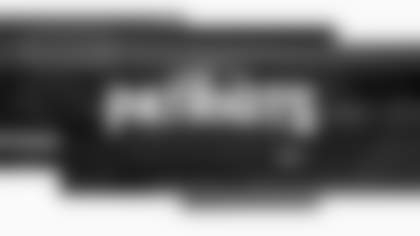Download / Print: Patriots Draft Prospect Guide (PDF) >
It's time for the fifth annual Patriots big board, where we'll rank the best fits for New England in the 2023 NFL Draft.
After a comprehensive deep-dive into the draft, these are the best fits for New England in this year's class, with an eye towards potential selections for the Patriots in the top 100. As a reminder, we don't include prospects out of the Patriots reach in the first round. For example, you will not see Alabama's Bryce Young or Ohio State quarterback C.J. Stroud.
Instead, we will focus on realistic targets who fit New England's mold based on film study, scheme fit, athletic testing, intangibles, and other trends in Bill Belichick's draft history. Over the previous four drafts, the big board hit on the following players: Marcus Jones, Mac Jones, Christian Barmore, Josh Uche, N'Keal Harry, Joejuan Williams, Chase Winovich, and Damien Harris.
Although the list is whittled down to roughly 50 players below, you can find more information on over 120 prospects in our Patriots draft prospect guide. You'll find film notes, prospect grades, positional rankings, and more useful information.
Here are the top Patriots fits in the 2023 NFL Draft after an extensive review of this year's class:
1. CB Christian Gonzalez, Oregon
Round projection: first
Searching for flaws in Gonzalez's game is like finding a needle in a haystack. The Oregon star is silky smooth in everything he does, with oily hips and efficient footwork to mirror receivers in man coverage while being an assignment-sound zone player in the Ducks' match coverages. Although there are other corners with better on-ball production, Gonzalez is in his own tier when it comes to sticking with receivers all over the field, making him a dream scenario for New England in the first round (pro comparison: Patrick Surtain).
2. WR Jaxon Smith-Njigba, Ohio State
Round projection: first
The Patriots eventually need to take a day-one swing on a wide receiver to solve their playmaker shortage, and JSN's 2021 season is better than any receiver's film in this class. The Ohio State product excels in the middle of the field. His separation quickness, route pacing, leverage manipulation, and gliding style into YAC mode make him a chain-moving machine. Some might covet a more explosive gear than JSN brings to the table, but it's hard to envision a scenario where, if healthy, Smith-Njigba doesn't have a 100-catch season before the end of his rookie contract (pro comparison: Amon-Ra St. Brown).
3. OT Paris Johnson, Ohio State
Round projection: first
Johnson has the highest floor of any tackle prospect in this class due to his ideal measurables, smooth mirroring slides on an island in pass protection, and effort in the running game. As a left tackle prototype, Johnson has the traits to get the job done immediately as a rookie with a battle-tested skill set and the footwork to make positional blocks in the running game. He'll need to improve his strike timing, anchor, and ability to leverage blocks, as he's susceptible to the occasional bull rush and doesn't get the most out of his power as a run blocker. Still, it's hard to pass up a ready-made left tackle (pro comparison: Russell Okung).
4. OT Broderick Jones, Georgia
Round projection: first
If you want a flashy tackle prospect with tremendous athletic upside, Jones is your guy. The Patriots don't often pick high enough in the first round to select a player with Jones's athletic profile. Although he'll need to be more consistent with his technique in pass protection to avoid getting off-balance, Jones's ability to block on the move makes him a weapon in the run and screen game. He moves in space like a tight end and has the baseline foot speed and body control to develop into a high-end pass blocker. Jones has the physical upside to become one of the best tackles in football (pro comparison: Terron Armstead).
5. CB Joey Porter Jr., Penn State
Round projection: first
With smaller slot types on the roster, the Patriots need size at outside cornerback, and Porter has that in droves with over an 80-inch wingspan at 6-2 and 193 pounds. Although he's the son of Steelers legend Joey Porter, Junior plays with a relaxed demeanor and was the same way when he addressed the media at the combine. He seldom panics in coverage, trusting his foot speed and making up for missteps with his ridiculous length. Along with smothering receivers at the line of scrimmage, his length consistently causes problems by clogging passing windows and contesting targets downfield. Porter isn't necessarily matchup-proof, as you don't want him guarding Tyreek Hill. Still, he has enough fluidity and speed to make an immediate impact (pro comparison: Sauce Gardner).
6. CB Devon Witherspoon, Illinois
Round projection: first
Witherspoon falls down the list slightly because his frame is similar to what the Patriots already have on the roster, but there's an endless amount of dog in that 5-foot-11, 181-pound body. Witherspoon plays football with his hair on fire, making more plays on the ball than any corner in this draft and punishing ball carriers with authority as a tackler. There aren't too many smallish corners playing with his competitiveness level, and he's very smooth at the top of the route to transition and stays glued to receivers. The only development area in his game is controlling that aggression in press-man, where he can get caught leaning in a certain direction, leading to some losses at the line. But Witherspoon has playmaking corner potential (pro comparison: Jaire Alexander).
7. WR Zay Flowers, Boston College
Round projection: first or second
Flowers is a polarizing prospect due to his smaller frame and the competition he faced in the ACC over the years. However, Flowers is an explosive play waiting to happen with the jitterbug quickness to separate on quick-hitters and immediately transition into YAC mode, where he forced 15 missed tackles as a ball carrier last season. He also has excellent vertical burst and is an outstanding salesman on double moves to create big plays on deep shots. Furthermore, despite concerns about his size, he caught seven of his 12 contested targets a year ago, routinely making up for subpar quarterback play at the catch point. For an offense that needs speed and big-play ability, Flowers is him (pro comparison: Deion Branch).
8. OT Peter Skoronski, Northwestern
Round projection: first
Skoronski doesn't have the prototypical size for an NFL offensive tackle, but I'm willing to bet he can thrive outside in the league because he's technically sound. Skoronski combines a noticeable explosive first step with refined balance and body control, hand usage, footwork to quickly recover and get to his landmarks, and hyper-aware eyes to sniff out schemed pressures. With 33 career starts, all at left tackle, Skoronski is by far the most experienced and pro-ready offensive lineman in this draft. However, his lack of length and stouter build projects better at guard. He sometimes has issues being the second to contact due to his arm length, inviting rushers into his chest and making it challenging to control engagements (pro comparison: Matt Light).
9. WR Jordan Addison, USC
Round projection: first or second
After testing as a slightly above-average athlete at the combine, Addison has flown under the radar since running a 4.49-second 40-yard dash in Indy. He's still one of the draft's surest bets at the receiver due to his route pacing, ability to eat up off-coverage, versatility, and ball skills. There aren't many warts to his game from a technical perspective, but Addison doesn't have the elite burst off the line that one would hope for his thin frame (5-11, 173 pounds) and struggled in the Pac-12 last season with press coverage on the outside. Still, a smart offensive coordinator who can scheme Addison away from early contact will get a highly productive player (pro comparison: Calvin Ridley).
10. CB Deonte Banks, Maryland
Round projection: first or second
Banks is a postseason riser for a good reason: he made a case for himself at the combine as the top athlete in the class, and his press-man film at Maryland was outstanding. Banks has the mirroring quickness to play soft-press or even off-man if he wants, but his aggressive jams at the line of scrimmage give receivers fits. There are reps where he lands such a heavy punch that it looks like a jammer taking out a gunner on a punt return. If the Patriots are sticking with their man coverage roots, don't be surprised if Banks is their first-round pick (pro comparison: Marlon Humphrey).
11. EDGE Tyree Wilson, Texas Tech
Round projection: first
I almost didn't include Wilson because he'll likely come off the board in the top ten. Plus, drafting an edge rusher at 14th overall doesn't fit New England's recent need-based drafting. With that said, Wilson plays like a man amongst boys with incredible power and length to destroy the line of scrimmage. However, teams picking in the top ten might have him lower on their boards because he doesn't have an elite first step or bend to turn the corner. This is a pocket caver, block-shedding, brute force player (pro comparison: Leonard Floyd).
12. OT Darnell Wright, Tennessee
Round projection: first or second
Another riser as draft evaluators got more familiar with his profile, Wright is one of 'my guys' in this draft because his game was at his best against elite competition. Wright's power, especially in his hands, is his standout trait. But he has above-average foot speed for a 340-pound tackle and is incredibly balanced in his pass-set posture, making him a human brick wall. After holding top pass-rusher Will Anderson to just two hurries last season, Wright solidified himself as a day-one prospect (pro comparison: La'El Collins).
13. TE Michael Mayer, Notre Dame
Round projection: first or second
Mayer is the consensus TE1 in one of the best tight end classes in recent memory. Although he doesn't have the juice others do in the passing game, the Irish target machine is a smooth mover with excellent hands and alignment flexibility. He logged snaps in-line, out of the slot, and flexed as an H-Back at Notre Dame, while also blocking at a high level from multiple spots. Mayer isn't the most athletic tight end prospect in this draft, but he's the most polished, and his consistency will be an immediate asset to any offense (pro comparison: T.J. Hockenson).
14. OT Dawand Jones, Ohio State
Round projection: first or second
There aren't too many humans on planet Earth that can move as easily as Jones at his size, earning him the nickname of "The Mountain" from yours truly. Jones, as you'd expect, is a bit heavy-footed at 6-8, 374 pounds. But it never seems to get in his way in pass protection, as he uses his immense length (36-inch arms) and hand strength to shut down pass-rushers before they even get started. As a run blocker, you know how it is, an absolute force, with people-moving strength for days as a legit difference-maker in that regard (pro comparison: Trent Brown).
15. OT Anton Harrison, Oklahoma
Round projection: first or second
Harrison is another tackle prospect who has flown under the radar. However, he's not among that group because he had nothing else to prove after a standout career for the Sooners. Harrison was a multi-year starter with the ideal build, excellent fluidity, and foot speed to pass protect on an island. He has arguably the most refined hand usage to work his hands independently to steer defenders with excellent strength. Harrison isn't as flashy as others on film, but he'll be a rock-solid pro (pro comparison: Christian Darrisaw).
16. DB Brian Branch, Alabama
Round projection: first
A smart team will trust the tape with Branch, ignoring a pedestrian combine to get a heck of a football player. Branch played the "star" role in Nick Saban's defense as an elite slot defender, where he can mirror slot receivers, instinctively switch onto threats and ballhawk as a match-zone player, and fit against the run with impressive strength for his size. His performance against Kansas State in the Sugar Bowl is in the running for the best tape in this class. Although he worked with the cornerbacks in Indy, Branch is a better safety prospect in the league, where he can use his instincts and ball skills to turn the football over. Finding a role for him at the next level might be challenging, but Belichick is great with those players (pro comparison: Micah Hyde).
17. EDGE Nolan Smith, Georgia
Round projection: first
Smith is a classic Patriot from a work ethic, leadership, and on-field standpoint. He was held in high regard by teammates and coaches at Georgia. While on film, he possesses excellent athletic traits to make a two-way impact with an elite 9.24 relative athletic score. Although he's undersized, Smith's lightning-quick first-step and hand usage allow him to test the corner on every pass rush rep, while he might be a better run defender with his excellent nose for the football and slithering style to slip into gaps. In recent years, the Pats have gravitated toward explosiveness at edge rusher with players like Josh Uche, making Smith more of a possibility than his smaller frame would suggest (pro comparison: Haason Reddick).
18. EDGE Lukas Van Ness, Iowa
Round projection: first
If the Patriots want a power rusher with a pocket-denting bull rush and a high motor against the run, Van Ness is their guy. Despite being more of a rotational player at Iowa, Van Ness is in the top-20 conversation because he lives up to his college nickname: Hercules. He's an incredibly strong and athletic rusher who gave Paris Johnson and Peter Skoronski fits over the years with his speed-to-power move. Van Ness is still developing as a run defender, where his block anticipation and hand usage to defeat blocks need work. He'll also need a consistent counter to his power moves as a pass rusher. But he has first-round talent with the potential to develop into a more complete pro than he was a college player (pro comparison: George Karlaftis).
19. CB Cam Smith, South Carolina
Round projection: first
Smith is another long, fluid, and speedy cornerback prospect in a loaded class. He has the long speed (4.43s) to run with receivers at all three levels and plays the game with a physical but calm temperament. Along with Devon Witherspoon, Smith has a case for being the most punishing tackler in this cornerback class, while he never shied away from top competition, lining up across from Jalin Hyatt and other elite receivers in the SEC. There's something in the water at South Carolina, which is becoming a cornerback factory (pro comparison: A.J. Bouye).
20. RB Bijan Robinson, Texas
Round projection: first
There are rumblings that the Patriots have fallen in love with Robinson, which could be a smoke screen or an acknowledgment that he's a tremendous football player without any intention of drafting him. Robinson is a generational talent and the best rookie running back since Saquon Barkley. The Texas star has unbelievable contact balance, power, and lateral agility for a bigger back, leading to an otherworldly 104 forced missed tackles and 1,071 yards after contact last season. Robinson is also a legit vertical threat out of the backfield and can hold up in pass protection. There's no denying the talent, but the Pats should consider the positional value of taking a running back in the first round (pro comparison: Saquon Barkley).
21. EDGE Myles Murphy, Clemson
Round projection: first
I'm struggling with where to slot Murphy. He's a well-built edge rusher with a prototypical profile to play the "elephant" linebacker role that started with guys like Willie McGinest. Murphy is a well-rounded player with some initial quickness to slip into gaps and the length+hand strength to dent the edge. However, his film lacks dominant games where he takes over, logging only 14 sacks over the last two seasons. Murphy is a solid player with high-character intangibles and a hybrid edge skillset. But he doesn't do anything spectacular on film, and that's what you want to see when you're drafting at 14th overall (pro comparison: Clelin Ferrell).
22. WR Quentin Johnston, TCU
Round projection: first or second
Johnston is the hardest player to evaluate in the draft through a Patriots lens. There's a lot to like about his linear skill set as a long-striding vertical threat with the ability to cruise past defenders over the top, create separation on intermediate comeback/stop patterns, and is an explosive mover after the catch. However, Johnston's athletic profile and limited route tree are eerily similar to past whiffs, while he's a body catcher who fails to attack the football downfield as his size would suggest he can (6-3, 208 pounds). There's a world where Johnston becomes a stud as a pro, but I'm reluctant to go down this road again (pro comparison: Treylon Burks).
23. TE Sam LaPorta, Iowa
Round projection: second
I'm willing to be on an island with LaPorta as my second-ranked tight end. The Iowa product had 111 catches for 1,327 yards over the last two years, is a superb athlete (9.02 RAS), and his elite separation quickness for a 245-pound receiver was backed up by an 88th percentile three-cone time (6.91s). LaPorta plays fast, is ridiculously quick through the top of the route, and averaged over six yards after the catch per reception with 20 forced miss tackles (via PFF). The Iowa product also ranks second in this class in yards per route run against man coverage (2.72). He might never develop into a people-moving blocker, but he gives good effort. With Bill O'Brien's ability to exploit matchups in the middle of the field, LaPorta has the tools to become a chain-moving engine for the Pats offense (pro comparison: George Kittle without the blocking chops).
24. TE Dalton Kincaid, Utah
Round projection: first or second
Kincaid caught 70 passes using his craftiness and strong hands, putting up 234 yards on 16 catches against USC in 2022. He will have a similar role in the league as LaPorta. But the Utah product's severe back injury, modest athletic profile, and limited exposure to contact as a non-blocking receiver gives me pause. Kincaid led all draft-eligible tight ends with 45 catches against zone coverage last season while averaging just 1.94 yards per route run vs. man coverage (13th among draft-eligible tight ends). Kincaid runs routes with vertical juice, deceptiveness, an excellent feel for finding soft spots in zones, and a slithering YAC style. Still, he has an injury history, and most of his production came against soft zone coverages. I like him, but not as much as everyone else. (pro comparison: Zach Ertz).
25. TE Darnell Washington, Georgia
Round projection: second
It's important to keep Washington's combine workout in perspective while discussing his evaluation. Yes, he's a 6-6, 264-pound cyborg with an elite athletic profile. His tape shows a bulldozing blocker, body control to adjust to the football, and flashes of high-end YAC ability. However, Washington is still a project. He only had 45 career catches at Georgia, is more of a builder of speed than an instant accelerator, and is unrefined as a blocker. Most importantly, you're projecting that he'll take off as a receiver due to his athletic traits and become an impact playmaker. This is a classic boom-or-bust prospect: he's either Rob Gronkowski or a more athletic Marcedes Lewis (pro comparison: discount Gronk).
26. RB Jahmyr Gibbs, Alabama
Round projection: second
There are rare players you evaluate on film who move at a different speed than everyone else, and that's Gibbs. He's simply the fast guy on the field, accelerating from zero to 60 MPH like a Bugatti Veyron on the Autobahnen. Along with brilliant breakaway speed, Gibbs has excellent versatility to catch passes either out of the backfield or flexed out wide as a receiver, where Alabama featured him since it was a down year at wideout for the Crimson Tide. If the Pats insist on taking a running back early, reuniting Gibbs with Bill O'Brien is my pick (pro comparison: Jamaal Charles).
27. WR Josh Downs, North Carolina
Round projection: second
Some teams might prefer taking Downs early on day two rather than Zay Flowers on day one. He's an incredibly crafty route runner who eats up defenders' leverage, has elite change-of-direction quicks, and is a better vertical threat than his slot profile would suggest. Downs is comparable to Flowers as a downfield separator, but he's lower on my board because he doesn't have the same playmaking ability after the catch. Downs would be a nice consolation prize (pro comparison: Darnell Mooney).
28. DB Kelee Ringo, Georgia
Round projection: first or second
As the number one corner for the national champs, Ringo was the consensus CB1 in this class heading into the 2022 season. He's a terrific straight-line athlete who can match vertical routes, makes explosive closes on the football, and use his size to smother releases and clog passing lanes in zone coverage. However, as the level of competition improved, Ringo's stiffness to mirror receivers at the top of the routes became apparent, and his poor agility testing at his Pro Day did him zero favors. To make a case for Ringo, there are two paths for NFL success: an outside corner who can specialize in covering bigger vertical threats or potentially an impact safety where he can use his straight-line speed and rocked-up frame to lay the wood while patrolling the middle of the field (pro comparison: Tyson Campbell).
29. CB Emmanuel Forbes, Mississippi State
Round projection: first or second
Forbes's projection into the Patriots defense is interesting because it'll tell us where they're heading schematically. With 14 career interceptions, Forbes is arguably the draft's best ball-hawking corner who uses his length, instincts, and 4.35-speed to jump routes all over the field. However, his press technique lacks patience and the hip fluidity to match dynamic route-runners at the break, while his slender frame could cause him to get out-muscled at the catch point (166 pounds). A secondary featuring Forbes, the Jones's trio, and safety Kyle Dugger would lead the league in pick-sixes. But it would be a feast or famine group (pro comparison: tall/skinny J.C. Jackson).
30. DL Adetomiwa Adebawore, Northwestern
Round projection: second
I was late to the party with the Senior Bowl and combine standout, but I'm glad Adebawore is on my radar now. Although some project him to play further out on the edge, my ideal role for Adebawore is a three-technique interior rusher. His 9.71 relative athletic score is all over the film with an urgent playmaking tempo, excellent first-step quickness off the ball, and the lateral quickness to add some inside-outside wiggle to his rushes. He also has above-average arm length and heavy hands to press blockers in the run game. Adebawore projects as the next undersized IDL prospect to blossom into a quarterback's worst nightmare (pro comparison: Ed Oliver with longer arms).
31. OT Blake Freeland, BYU
Round projection: second or third
This one is easy to summarize for Patriots fans: Freeland is a Nate Solder clone. The BYU product is a skyscraper at 6-foot-8, 305 pounds who converted from tight end early on in his collegiate career. His tight end background makes him light on his feet, while he has some people-moving strength to get on a double team and move the line of scrimmage and can add more mass. Like Solder, Freeland's height sometimes worked against him against explosive edge rushers who can bend the arc. But there's enough baseline foot speed and functional power to project a starting left tackle here (pro comparison: Nate Solder).
32. OT Matthew Bergeron, Syracuse
Round projection: second or third
Bergeron is a clean offensive line prospect that projects inside to guard but has enough length (33 ¾" arms) to try him out at tackle. The Syracuse product logged time at both tackle spots as a tone-setting blocker with an aggressive mindset to run blocking. His latch strength and ability to direct defenders where he wants them to go is dominant at times, while routinely caving in the line of scrimmage on double-team blocks. Bergeron with a solid base and ability to drop anchor in pass protection. But heavy-footed reps, limited range, and early opening outside hip led to allowing five sacks last year. Ideally, he's a high-level guard that can play tackle if necessary. But it wouldn't surprise me to see the Pats try him out at right tackle (pro comparison: Marcus Cannon).
33. CB Julius Brents, Kansas State
Round projection: second or third
From a pure measurables standpoint, Brents is exactly what the doctor ordered for the Patriots at outside corner at nearly 6-foot-3, 198 pounds with 34-inch arms (98th percentile). As his Senior Bowl practices film can attest, Brents has silky-smooth change of direction ability to mirror routes, experience covering receivers on an island in K-State's man schemes, and his length is a factor. However, Brents is not a finished product. His long speed is only modest, and it tends to cause issues in the final phase of the play, where he's often grabby and loses at the catch point. Brents needs to trust his technique and learn to play more consistently with his back to the quarterback. As far as big corners go, he has all the tools to match up on the outside (pro comparison: Byron Jones).
34. OL Cody Mauch, North Dakota State
Round projection: second or third
Mauch was one of my favorite guys to study on film in this offensive line class, but his game has too many limitations to play him at tackle. He's a mauler with a mean streak and an elite first step to generate immediate movement, work to the second level and beyond, and plays through the whistle like offensive line coaches dream about. But his compact frame and footwork lead to issues outside, where he doesn't have the fluidity or length to translate at tackle. Mauch will be a starting-caliber interior lineman at either guard or center (pro comparison: Mitch Morse).
35. TE Tucker Kraft, South Dakota State
Round projection: second or third
Kraft is your typical small-school Patriots prospect, dominating at his level of competition. The Pats also took from the Jackrabbits' offense with Pierre Strong a year ago. Kraft is a stellar athlete with noticeable straight-line speed, great hands with a large catch radius, an innate ability to find the soft spots in zone coverages, and elite YAC ability averaging over seven YAC per reception. Although he's not a great in-line blocker yet, Kraft can effectively block on the move and in space. He'll be a useful Swiss army knife at the next level (pro comparison: bigger Gerald Everett).
36. EDGE Derick Hall, Auburn
Round projection: second or third
Hall was a three-year starter and team captain for the Tigers who won't ever make you worry about setting the edge against the run. Hall's length and terrific hand strength allow him to control the edge of the defense with a post-up style that the Patriots will love. He also uses his stride length effectively and explosive downhill style to collapse the pocket while destroying quarterbacks in the pocket. The Auburn product held up okay in low-stress coverage drops as well. Hall is violent on the field, so don't expect a bendy Josh Uche-type here, but he checks every box for New England (pro comparison: Carl Lawson).
37. EDGE Isaiah Foskey, Notre Dame
Round projection: second or third
Despite the talent coming out of South Bend each year, the Patriots haven't selected an Irishman since the 2007 draft. Although there could be a reason for the decade-plus avoidance of Notre Dame, Foskey is a great fit. The long-limbed edge rusher can play either in a two-point stance as an outside linebacker or has the functional power to rush with his hand in the dirt (see back-to-back goal-line stuffs vs. UNC). Foskey uses an effective long arm as a foundational pass-rush move, locking out his length to soften the corner, and will nicely counter that with a "ghost" rush or push-pull technique. He needs to become more consistent as an edge-setter against the run, but he has savvy in his pass-rush plan and the tools to develop into a more well-rounded player (pro comparison: Harold Landry).
38. CB D.J. Turner, Michigan
Round projection: second or third
Turner had the best 40-yard dash time at this year's combine at 4.26 seconds, and his play speed matches his terrific athletic testing. Whether it's closing on the ball from off-coverage or running with speedy receivers all over the field, Turner is an easy mover with a bit more length (5-11) while still matching the mirroring quickness New England often targets (pro comparison: Johnathan Joseph).
39. LB Jack Campbell, Iowa
Round projection: second or third
Although it's a down year for inside linebackers, Campbell dazzled at the combine and is a throwback inside linebacker on film. His athletic profile (9.98 RAS) suggests he can hang in space in the league, while Campbell is an instinctive tackling machine with natural skills to play the MIKE linebacker position. He has outstanding lateral agility to scrape from the second level with square shoulders to the line of scrimmage, sliding gap-to-gap with running backs before closing downhill in a hurry. Overall, Campbell could have a 100-plus tackle season in his future (pro comparison: Leighton Vander Esch).
40. LB Drew Sanders, Arkansas
Round projection: second
Sanders is an intriguing do-it-all prospect with enough length to press blocks in a Patriots-like style, straight-line speed to close in pursuit or serve as a QB spy, and on-ball versatility to rush the passer. The Pats haven't drafted an off-ball linebacker in the first four rounds since 2013 (Jamie Collins), but Sanders could change that because of his versatility and much-needed athleticism in space (pro comparison: Pete Werner).
41. DT Mazi Smith, Michigan
Round projection: second or third
Alabama head coach Nick Saban once told Georgia head coach Kirby Smart that Bill Belichick goes to the combine to scout players with large…posteriors. Smith would certainly qualify, and he went to a school that the Pats always dip into. The Michigan product has a dense build with above-average arm length to eat blocks as either an A-Gap shade or a straight-up nose tackle. Smith's upper-body power to press, shed, and flat-out toss blockers off of him makes for some eye-popping reps on film, while there's some suddenness to his pass rush as well (pro comparison: Alan Branch).
42. S Jordan Battle, Alabama
Round projection: second or third
As the purest free safety from Alabama's secondary last season, Battle is an underrated prospect with the versatility to play center field, man coverage closer to the line of scrimmage, or catch receivers in Saban's match zones downfield. He flashes the ability to high-point the ball, like his interception against K-State, and sifts through vertical threats on his perch. Battle is also well-built with above-average size for man coverage duties and in run support. He'd add another interchangeable piece in the backend (pro comparison: Jordan Poyer).
43. WR Marvin Mims, Oklahoma
Round projection: second or third
Mims has several things going for him that make him an intriguing mid-round receiver prospect, starting with outstanding production and an impressive athletic profile with a 4.38-second 40-yard dash. He can use his speed to stretch the defense vertically and horizontally, making outstanding acrobatic catches when facing tight coverage on the boundary. The Pats already have a developmental burner on the roster in Tyquan Thornton, but Mims is further along with his ball skills (pro comparison: David Patten).
44. DB Jartavius Martin, Illinois
Round projection: third or fourth
I'd love to know why Martin isn't receiving more pre-draft buzz as a highly versatile player with a 9.29 relative athletic score. He has experience playing both corner and free safety, presenting the cover skills to play a nickel role while also bringing explosiveness and range as a deep safety. Martin's best path to NFL success is at safety, but he's interchangeable and smooth enough in man coverage to play anywhere (pro comparison: Juan Thornhill).
45. DB Riley Moss, Iowa
Round projection: third or fourth
Moss is a heady, instinctive athlete with over 2,000 career snaps in college, mostly at outside corner. He brings some size to the room at 6-1, 193 pounds while understanding his 1/11th in zone structures and has the long speed to carry vertical receivers in man (4.45s). With his closing speed and ball-hawking instincts, Moss could also transition to safety, where he'll have a chance to make a McCourty-like leap as a rangy playmaker while covering up some hip stiffness. Our initial instinct is to trust his anticipation and speed as a corner (pro comparison: Jason McCourty).
46. WR Charlie Jones, Purdue
Round projection: fourth round
If we're banging the table for mid-round receiver prospects, Jones is the guy. The Purdue product is coming off a monster season after transferring from Iowa with 110 catches, 1,361 yards, and 12 touchdowns. He combines great initial burst off the line with outstanding separation quickness at the top of routes, stopping on a dime with quick three-step breaks on comebacks and horizontal cuts. Jones also has excellent ball skills that routinely allow him to make catches in traffic. The Purdue product is one of the best technicians in the class with legit play speed, backed up by his 4.43-second 40-yard dash (pro comparison: Adam Thielen).
47. OT Tyler Steen, Alabama
Round projection: third or fourth
Although he only spent one season with Bill O'Brien in Tuscaloosa, Steen held down the left tackle spot for the Crimson Tide and delivered a very solid season. Steen blocks with a sturdy base to generate power, uses a strong inside hand to widen the pocket, has enough foot speed to mirror edge rushers on an island, and recovers quickly. His body is built more like a guard, though, as his shorter arms and thick frame suggest he'd be better on the inside. Still, as a mid-round guy, he has starting value at four different positions (pro comparison: Max Scharping).
48. TE Luke Schoonmaker, Michigan
Round projection: third or fourth
Schoonmaker might be the underrated gem in a stacked tight end class. The Michigan product is an NFL-ready blocker with the baseline fundamentals and an advanced understanding of angles. He also is a standout athlete, clocking in a 4.63-second 40-yard dash, and shows he has the juice to threaten defenses on crossers and seam runs in play-action concepts. Although he wasn't a featured pass-catcher at Michigan, Schoonmaker's athletic profile suggests he'll be a more impactful pro in the passing game while bringing starting-caliber blocking to the table (pro comparison: Dalton Schultz).
49. TE Zack Kuntz. Old Dominion
Round projection: third or fourth
According to relative athletic score, Kuntz is the most athletic tight end to ever work out at the combine (10.0 RAS). Yes, you read that correctly. At 6-6, 255 pounds, Kuntz ran a 4.55-second 40, with a 40-inch vertical and an insane 6.87-second three-cone. His athletic ability translated to a 73-catch season as a junior before an injury derailed his senior season. Kuntz isn't a blocker, but he's a matchup nightmare with vertical burst, some wiggle to uncover, and a tremendous catch radius (pro comparison: Mike Gesicki).
50. WR Jonathan Mingo, Ole Miss
Round projection: third or fourth
Mingo is a classic size-speed prospect with a noticeable burst off the line to stretch a defense and enticing versatility. The first thing that stands out is how well he moves at 6-2, 220 pounds, with a 4.46-second 40. He can also present matchup issues as a big slot, play snaps as an H-Back, and shows some lateral agility to get off press coverage on the outside. Mingo isn't a natural separator at the top of routes, but his speed and large frame give him a chance as a big play threat (pro comparison: discount A.J. Brown).
51. EDGE Tyrus Wheat, Mississippi State
Round projection: fourth or fifth
Alright, I cheated. But only because the Patriots are considering drafting a running back in the first round. The Patriots coaching staff raved about Wheat's versatility and ability to execute New England-specific assignments at the Shrine Bowl. Wheat uses above-average flexibility and upper-body power to set a firm edge to the defense, standing up tackles, tight ends, and combo blocks against the run. He also packs a punch coming downhill at the line of scrimmage, generates some pass-rush juice by converting speed to power, and has experience dropping into coverage. Wheat logged snaps all over the Bulldogs' defensive front, displaying excellent on and off-the-line versatility. He looks and plays like a Patriot (pro comparison: discount Dont'a Hightower).
52. CB Terell Smith, Minnesota
Round projection: fourth or fifth
Okay, one more. I promise. As a late addition to the big board, Smith was arguably the best player on the field during West squad practices at the Shrine Bowl. He brings size to the room at six feet, 204 pounds with 32 7/8" arms (91st percentile), and the foot speed to match receivers in press-man coverage (4.41s 40). Smith shut down receiver after receiver in Vegas, using his mirroring quickness and length to make plays at the catch point. He also has the closing burst to break up passes from off-coverage and is a willing tackler in run support. Smith would have more hype in a less crowded cornerback class (pro comparison: James Bradberry).
Last three off: OT Nick Saldiveri (Old Dominion), EDGE Will McDonald IV (Iowa State), QB Dorian Thompson-Robinson (UCLA)
Download / Print: Patriots Draft Prospect Guide (PDF) >
DISCLAIMER: The views and thoughts expressed in this article are those of the writer and don't necessarily reflect those of the organization. Read Full Disclaimer











































